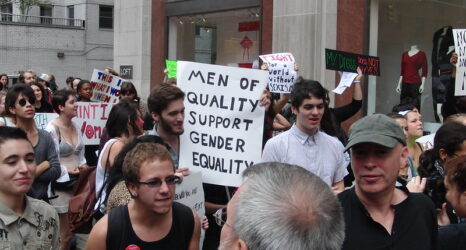Earlier this month, thousands of people in Berlin held a vigil for Tugce Albayrak, a 23-year-old student who died at the hands of a street harasser. Albayrak bravely intervened when she witnessed a group of men harassing two teenage girls on November 15. In retaliation, one of the young men, an 18-year-old, turned on her, beating her into a coma from which she never awoke. Her death is senseless and horrific, and people around the world are rightly outraged.
She isn’t the only one to be murdered or seriously injured while intervening with a harasser. In October, an Egyptian teenager was stabbed to death while stopping to help young women experiencing harassment. In March, a Chicago man was killed by a harasser in front of his 15-year-old daughter after he confronted the man for making “inappropriate gestures” at his daughter. Last month a San Francisco man sustained life-threatening injuries after asking a harasser to leave his girlfriend alone. A Philadelphia man was hospitalized after he told a harasser to watch what he was saying to women nearby, and the harasser got out of his vehicle and attacked him.
And then there have been the horrific incidents in which harassed women have been hurt or killed. There was the woman in Detroit who was shot dead after refusing to give a stranger her phone number. The woman in New York whose throat was slashed by a man she refused to go on a date with. The woman in Seattle who faced a man’s gun after she ignored his repeated invitations to “hang out.” And the two transwomen in Atlanta who were harassed and then violently attacked in a subway car, prompting them to move from the city.
While these stories of toxic, violent masculinity may seem extreme, they’re not unusual or new. Violence that starts as harassment is as old as oppression itself, and women (plus other oppressed groups) have always been punished for resisting. In a nationally representative study commissioned by Stop Street Harassment and conducted by survey firm GfK this year, 41 percent of women [PDF] had experienced physically aggressive harassment. This ranged from being followed (20 percent) to being sexually touched (23 percent) to being forced to do something sexual (9 percent). One only need look at the Tumblr When Women Refuse or the Twitter hashtag #YesAllWomen, both started after Elliot Rodger’s women-hating shooting spree this year, to find stories to match the statistics.
Street harassment isn’t a compliment. From verbal demands to smile or to say one’s name, phone number or destination; to homophobic, sexist or racial slurs; to physically invading someone’s space, street harassment is about power and control. It’s often about men’s need to control women, and when women don’t agree to it —or when a bystander intervenes on their behalf—some men lash out. We never know which men will.
So how are we to respond? What can we, as a target of, or witness to, harassment, do?
Many believe silence is the best strategy, but the answer is that there’s no one “right” way. Whether you pretend to ignore a harasser or stand up to him, the situation may escalate to violence, as happened in Seattle, New York and Detroit. Hopefully, the more strategies you have at hand, the more empowered you’ll feel. Here are three strategies you might try when being harassed:
1. Talk directly to the harasser, telling him calmly what you want him to do (“Stop touching me,” or “That’s disrespectful. Don’t call me ‘baby.’”). Tell him what he’s doing that you don’t like (“You’re standing too close”) rather than characterizing him (“You’re such a creep.”). Avoid cursing, name-calling and put-downs.
Be prepared for him to call you names—something he may also do if you’re silent. Just call it a success if you’ve said what you want to say and feel safe walking away.
2. Enlist bystanders, either by directly asking for help, going to stand or walk with them, or yelling loudly. If you are a bystander, you can ask the target if she needs help, you can get others involved, you can join the target in speaking up to the harasser, and more.
3. Preempt harassment by humanizing yourself: Look at people on the street and greet them (“Hi, how’re you doing?”).
Only you can choose the best response in a given situation. Are other people around? How far are you from help? How committed does the harasser seem? How scared or pissed off are you?
There are two important reasons you may want to stand up to harassers. First, verbal harassment and low-key touching (a pinch, a grope, unnecessary body contact) can be a harasser’s way of testing how far he can go. Many harassers take a passive response as a green light for further violation. Second, we don’t want to let harassers silence us. If we keep our mouths shut and make ourselves small, our lives are ruled by fear, and we unintentionally give harassers permission to continue exerting their dominance.
We’re often in positions where we risk harm if we assert our rights. But if we never assert our rights, we don’t really have them.
Photo from Flickr user Ted Eytan under license from Creative Commons 2.0 of 2011 march in Washington, D.C., called “Our Streets, Too!”





